Shi-Yuan Ma
Micro-Ring Perceptron Sensor for High-Speed, Low-Power Radio-Frequency Signal
Apr 19, 2025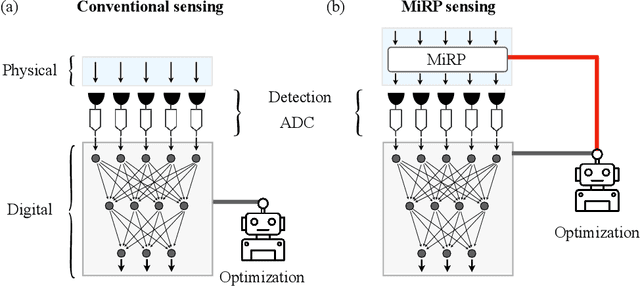
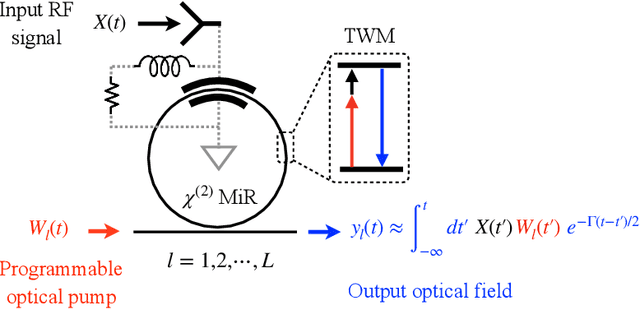
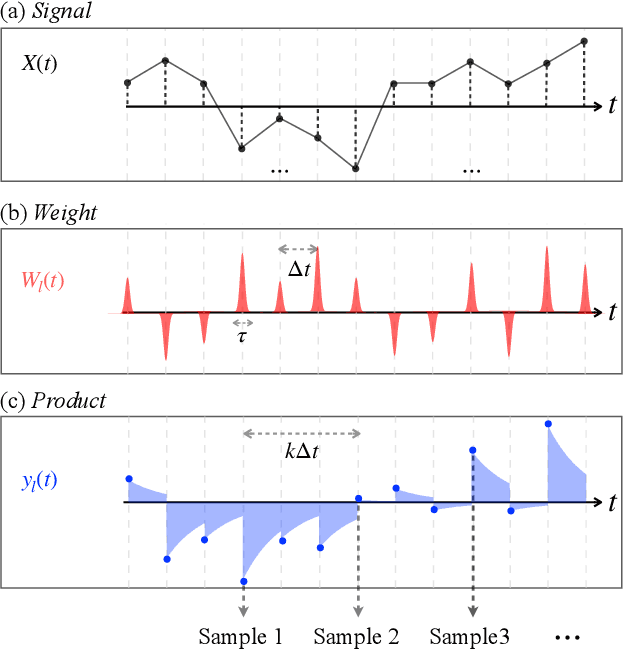
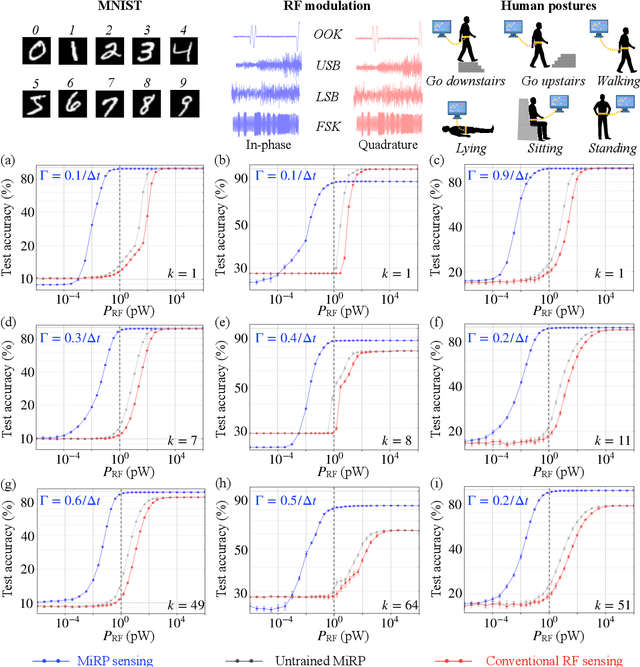
Abstract:Radio-frequency (RF) sensing enables long-range, high-resolution detection for applications such as radar and wireless communication. RF photonic sensing mitigates the bandwidth limitations and high transmission losses of electronic systems by transducing the detected RF signals into broadband optical carriers. However, these sensing systems remain limited by detector noise and Nyquist rate sampling with analog-to-digital converters, particularly under low-power and high-data rate conditions. To overcome these limitations, we introduce the micro-ring perceptron (MiRP) sensor, a physics-inspired AI framework that integrates the micro-ring (MiR) dynamics-based analog processor with a machine-learning-driven digital backend. By embedding the nonlinear optical dynamics of MiRs into an end-to-end architecture, MiRP sensing maps the input signal into a learned feature space for the subsequent digital neural network. The trick is to encode the entire temporal structure of the incoming signal into each output sample in order to enable effectively sub-Nyquist sampling without loss of task-relevant information. Evaluations of three target classification datasets demonstrate the performance advantages of MiRP sensing. For example, on MNIST, MiRP detection achieves $94\pm0.1$\% accuracy at $1/49$ the Nyquist rate at the input RF signal of $1$~ pW, compared to $11\pm0.4$\% for the conventional RF detection method. Thus, our sensor framework provides a robust and efficient solution for the detection of low-power and high-speed signals in real-world sensing applications.
Quantum-noise-limited optical neural networks operating at a few quanta per activation
Jul 28, 2023



Abstract:Analog physical neural networks, which hold promise for improved energy efficiency and speed compared to digital electronic neural networks, are nevertheless typically operated in a relatively high-power regime so that the signal-to-noise ratio (SNR) is large (>10). What happens if an analog system is instead operated in an ultra-low-power regime, in which the behavior of the system becomes highly stochastic and the noise is no longer a small perturbation on the signal? In this paper, we study this question in the setting of optical neural networks operated in the limit where some layers use only a single photon to cause a neuron activation. Neuron activations in this limit are dominated by quantum noise from the fundamentally probabilistic nature of single-photon detection of weak optical signals. We show that it is possible to train stochastic optical neural networks to perform deterministic image-classification tasks with high accuracy in spite of the extremely high noise (SNR ~ 1) by using a training procedure that directly models the stochastic behavior of photodetection. We experimentally demonstrated MNIST classification with a test accuracy of 98% using an optical neural network with a hidden layer operating in the single-photon regime; the optical energy used to perform the classification corresponds to 0.008 photons per multiply-accumulate (MAC) operation, which is equivalent to 0.003 attojoules of optical energy per MAC. Our experiment used >40x fewer photons per inference than previous state-of-the-art low-optical-energy demonstrations, to achieve the same accuracy of >90%. Our work shows that some extremely stochastic analog systems, including those operating in the limit where quantum noise dominates, can nevertheless be used as layers in neural networks that deterministically perform classification tasks with high accuracy if they are appropriately trained.
Optical Transformers
Feb 20, 2023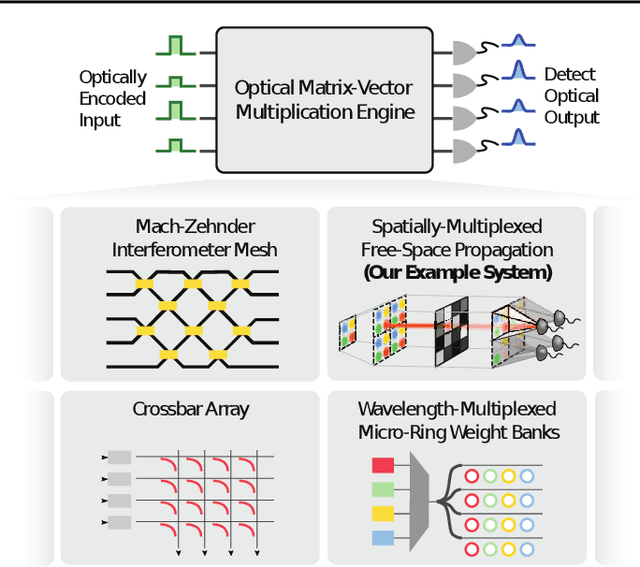
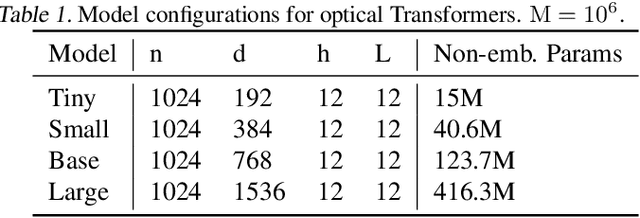
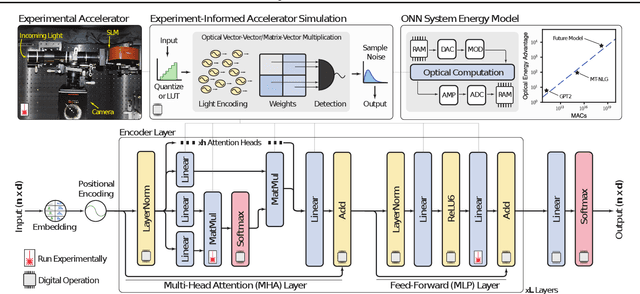

Abstract:The rapidly increasing size of deep-learning models has caused renewed and growing interest in alternatives to digital computers to dramatically reduce the energy cost of running state-of-the-art neural networks. Optical matrix-vector multipliers are best suited to performing computations with very large operands, which suggests that large Transformer models could be a good target for optical computing. To test this idea, we performed small-scale optical experiments with a prototype accelerator to demonstrate that Transformer operations can run on optical hardware despite noise and errors. Using simulations, validated by our experiments, we then explored the energy efficiency of optical implementations of Transformers and identified scaling laws for model performance with respect to optical energy usage. We found that the optical energy per multiply-accumulate (MAC) scales as $\frac{1}{d}$ where $d$ is the Transformer width, an asymptotic advantage over digital systems. We conclude that with well-engineered, large-scale optical hardware, it may be possible to achieve a $100 \times$ energy-efficiency advantage for running some of the largest current Transformer models, and that if both the models and the optical hardware are scaled to the quadrillion-parameter regime, optical computers could have a $>8,000\times$ energy-efficiency advantage over state-of-the-art digital-electronic processors that achieve 300 fJ/MAC. We analyzed how these results motivate and inform the construction of future optical accelerators along with optics-amenable deep-learning approaches. With assumptions about future improvements to electronics and Transformer quantization techniques (5$\times$ cheaper memory access, double the digital--analog conversion efficiency, and 4-bit precision), we estimated that optical computers' advantage against current 300-fJ/MAC digital processors could grow to $>100,000\times$.
Image sensing with multilayer, nonlinear optical neural networks
Jul 27, 2022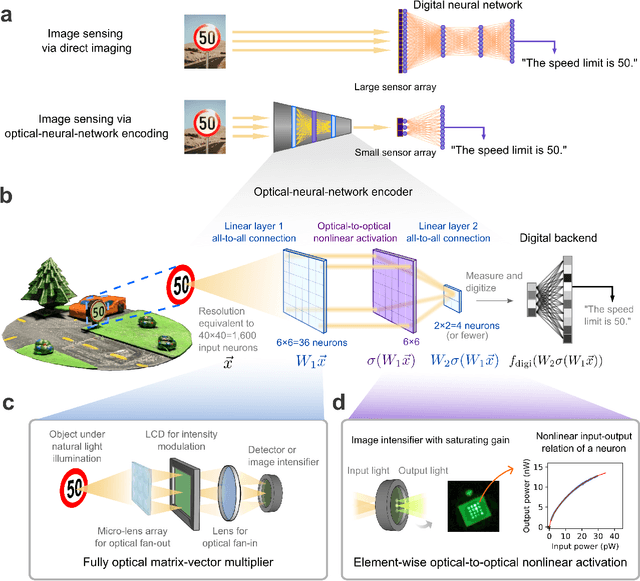
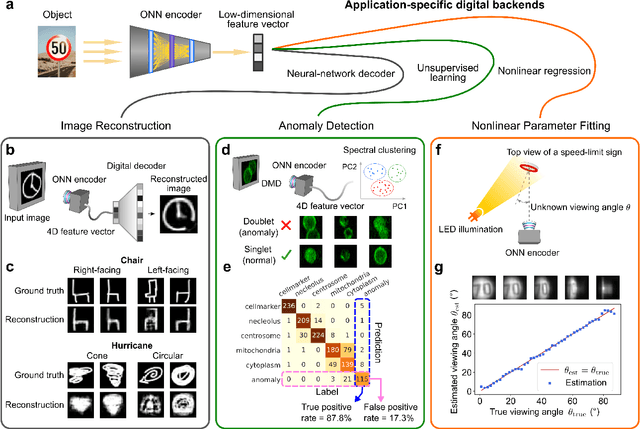
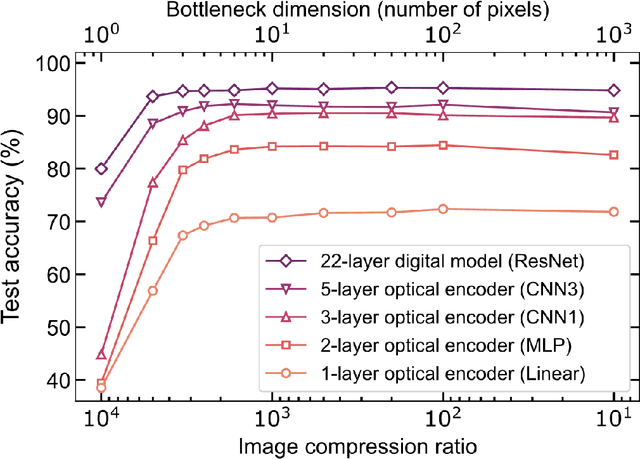
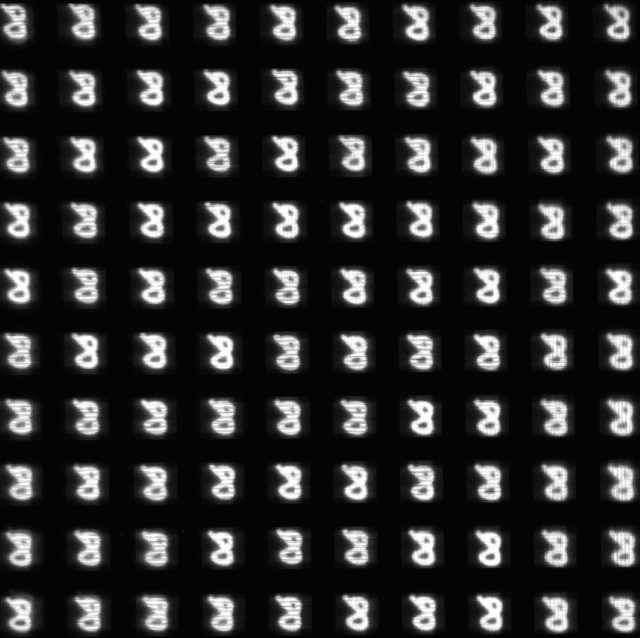
Abstract:Optical imaging is commonly used for both scientific and technological applications across industry and academia. In image sensing, a measurement, such as of an object's position, is performed by computational analysis of a digitized image. An emerging image-sensing paradigm breaks this delineation between data collection and analysis by designing optical components to perform not imaging, but encoding. By optically encoding images into a compressed, low-dimensional latent space suitable for efficient post-analysis, these image sensors can operate with fewer pixels and fewer photons, allowing higher-throughput, lower-latency operation. Optical neural networks (ONNs) offer a platform for processing data in the analog, optical domain. ONN-based sensors have however been limited to linear processing, but nonlinearity is a prerequisite for depth, and multilayer NNs significantly outperform shallow NNs on many tasks. Here, we realize a multilayer ONN pre-processor for image sensing, using a commercial image intensifier as a parallel optoelectronic, optical-to-optical nonlinear activation function. We demonstrate that the nonlinear ONN pre-processor can achieve compression ratios of up to 800:1 while still enabling high accuracy across several representative computer-vision tasks, including machine-vision benchmarks, flow-cytometry image classification, and identification of objects in real scenes. In all cases we find that the ONN's nonlinearity and depth allowed it to outperform a purely linear ONN encoder. Although our experiments are specialized to ONN sensors for incoherent-light images, alternative ONN platforms should facilitate a range of ONN sensors. These ONN sensors may surpass conventional sensors by pre-processing optical information in spatial, temporal, and/or spectral dimensions, potentially with coherent and quantum qualities, all natively in the optical domain.
An optical neural network using less than 1 photon per multiplication
Apr 27, 2021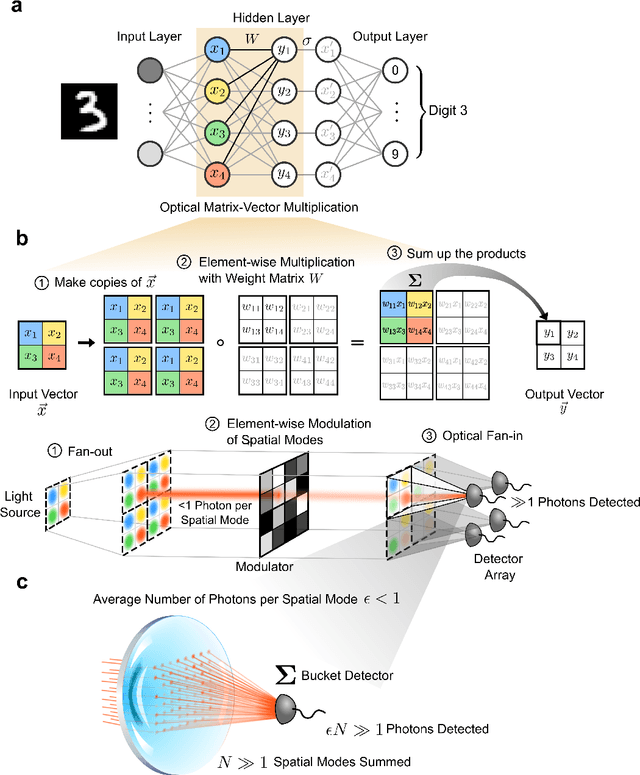
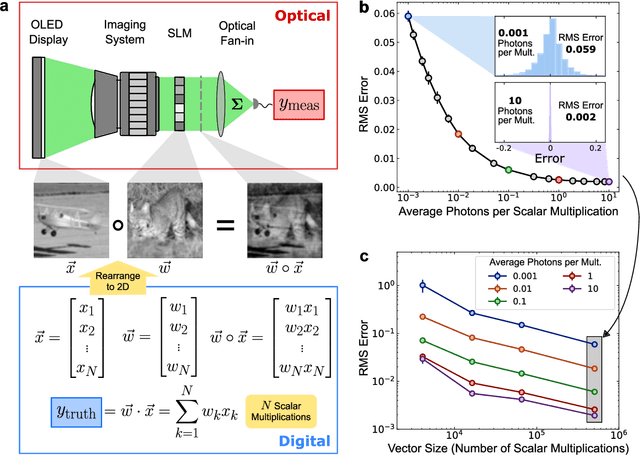
Abstract:Deep learning has rapidly become a widespread tool in both scientific and commercial endeavors. Milestones of deep learning exceeding human performance have been achieved for a growing number of tasks over the past several years, across areas as diverse as game-playing, natural-language translation, and medical-image analysis. However, continued progress is increasingly hampered by the high energy costs associated with training and running deep neural networks on electronic processors. Optical neural networks have attracted attention as an alternative physical platform for deep learning, as it has been theoretically predicted that they can fundamentally achieve higher energy efficiency than neural networks deployed on conventional digital computers. Here, we experimentally demonstrate an optical neural network achieving 99% accuracy on handwritten-digit classification using ~3.2 detected photons per weight multiplication and ~90% accuracy using ~0.64 photons (~$2.4 \times 10^{-19}$ J of optical energy) per weight multiplication. This performance was achieved using a custom free-space optical processor that executes matrix-vector multiplications in a massively parallel fashion, with up to ~0.5 million scalar (weight) multiplications performed at the same time. Using commercially available optical components and standard neural-network training methods, we demonstrated that optical neural networks can operate near the standard quantum limit with extremely low optical powers and still achieve high accuracy. Our results provide a proof-of-principle for low-optical-power operation, and with careful system design including the surrounding electronics used for data storage and control, open up a path to realizing optical processors that require only $10^{-16}$ J total energy per scalar multiplication -- which is orders of magnitude more efficient than current digital processors.
 Add to Chrome
Add to Chrome Add to Firefox
Add to Firefox Add to Edge
Add to Edge